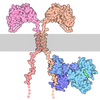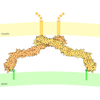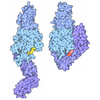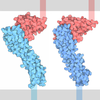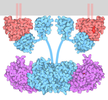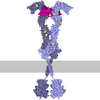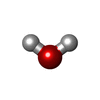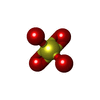Entry Database : PDB / ID : 5qu2Title Crystal Structure of human Nck SH3.1 in complex with peptide PPPVPNPDY ACE-PRO-PRO-PRO-VAL-PRO-ASN-PRO-ASP-TYR-NH2 Cytoplasmic protein NCK1 Keywords / / / / Function / homology Function Domain/homology Component
/ / / / / / / / / / / / / / / / / / / / / / / / / / / / / / / / / / / / / / / / / / / / / / / / / / / / / / / / / / / / / / / / / / / / / / / / / / / / / / / / / / / / / / / / / / / / / / / / / / / / / / / / / / / / / / / / / / / / / / / / / / / / / / / / / / / / / / / / / / / / / / Biological species Homo sapiens (human)synthetic construct (others) Method / / / Resolution : 1.04 Å Authors Rudolph, M.G. Journal : J.Biol.Chem. / Year : 2020Title : Small molecule AX-024 reduces T cell proliferation independently of CD3ε/Nck1 interaction, which is governed by a domain swap in the Nck1-SH3.1 domain.Authors : Richter, K. / Rufer, A.C. / Muller, M. / Burger, D. / Casagrande, F. / Grossenbacher, T. / Huber, S. / Hug, M.N. / Koldewey, P. / D'Osualdo, A. / Schlatter, D. / Stoll, T. / Rudolph, M.G. History Deposition Dec 13, 2019 Deposition site / Processing site Revision 1.0 Feb 12, 2020 Provider / Type Revision 2.0 Feb 26, 2020 Group Advisory / Atomic model ... Advisory / Atomic model / Data collection / Database references / Derived calculations / Polymer sequence / Source and taxonomy / Structure summary Category atom_site / atom_site_anisotrop ... atom_site / atom_site_anisotrop / entity / entity_poly / entity_poly_seq / pdbx_entity_nonpoly / pdbx_entity_src_syn / pdbx_nonpoly_scheme / pdbx_poly_seq_scheme / pdbx_struct_assembly_gen / pdbx_struct_special_symmetry / pdbx_validate_close_contact / pdbx_validate_polymer_linkage / struct_asym / struct_conn / struct_ref_seq / struct_site / struct_site_gen Item _atom_site.B_iso_or_equiv / _atom_site.Cartn_x ... _atom_site.B_iso_or_equiv / _atom_site.Cartn_x / _atom_site.Cartn_y / _atom_site.Cartn_z / _atom_site.auth_asym_id / _atom_site.auth_atom_id / _atom_site.auth_comp_id / _atom_site.auth_seq_id / _atom_site.group_PDB / _atom_site.label_alt_id / _atom_site.label_asym_id / _atom_site.label_atom_id / _atom_site.label_comp_id / _atom_site.label_entity_id / _atom_site.label_seq_id / _atom_site.occupancy / _atom_site.type_symbol / _atom_site_anisotrop.U[1][1] / _atom_site_anisotrop.U[1][2] / _atom_site_anisotrop.U[1][3] / _atom_site_anisotrop.U[2][2] / _atom_site_anisotrop.U[2][3] / _atom_site_anisotrop.U[3][3] / _atom_site_anisotrop.pdbx_auth_asym_id / _atom_site_anisotrop.pdbx_auth_atom_id / _atom_site_anisotrop.pdbx_auth_comp_id / _atom_site_anisotrop.pdbx_auth_seq_id / _atom_site_anisotrop.pdbx_label_alt_id / _atom_site_anisotrop.pdbx_label_asym_id / _atom_site_anisotrop.pdbx_label_atom_id / _atom_site_anisotrop.pdbx_label_comp_id / _atom_site_anisotrop.pdbx_label_seq_id / _atom_site_anisotrop.type_symbol / _entity_poly.pdbx_seq_one_letter_code / _entity_poly.pdbx_seq_one_letter_code_can / _pdbx_entity_src_syn.pdbx_beg_seq_num / _pdbx_entity_src_syn.pdbx_end_seq_num / _pdbx_struct_assembly_gen.asym_id_list / _pdbx_struct_special_symmetry.label_asym_id / _struct_ref_seq.db_align_end / _struct_ref_seq.pdbx_auth_seq_align_end / _struct_ref_seq.seq_align_end Revision 2.1 May 12, 2021 Group / Structure summary / Category / struct_connItem _pdbx_deposit_group.group_description / _pdbx_deposit_group.group_type ... _pdbx_deposit_group.group_description / _pdbx_deposit_group.group_type / _struct_conn.pdbx_dist_value / _struct_conn.pdbx_ptnr1_label_alt_id / _struct_conn.pdbx_ptnr2_label_alt_id / _struct_conn.pdbx_value_order / _struct_conn.ptnr1_auth_asym_id / _struct_conn.ptnr1_auth_comp_id / _struct_conn.ptnr1_auth_seq_id / _struct_conn.ptnr1_label_asym_id / _struct_conn.ptnr1_label_comp_id / _struct_conn.ptnr1_label_seq_id / _struct_conn.ptnr2_auth_asym_id / _struct_conn.ptnr2_auth_comp_id / _struct_conn.ptnr2_auth_seq_id / _struct_conn.ptnr2_label_asym_id / _struct_conn.ptnr2_label_comp_id / _struct_conn.ptnr2_label_seq_id Revision 2.2 Jun 30, 2021 Group / Category / citation_authorItem _citation.country / _citation.journal_abbrev ... _citation.country / _citation.journal_abbrev / _citation.journal_id_ASTM / _citation.journal_id_CSD / _citation.journal_id_ISSN / _citation.journal_volume / _citation.page_first / _citation.page_last / _citation.pdbx_database_id_DOI / _citation.pdbx_database_id_PubMed / _citation.title / _citation.year Revision 2.3 Apr 3, 2024 Group / Database references / Refinement descriptionCategory chem_comp_atom / chem_comp_bond ... chem_comp_atom / chem_comp_bond / citation / database_2 / pdbx_initial_refinement_model Item / _database_2.pdbx_DOI / _database_2.pdbx_database_accessionRevision 2.4 Oct 23, 2024 Group / Category / pdbx_modification_feature
Show all Show less
 Yorodumi
Yorodumi Open data
Open data Basic information
Basic information Components
Components Keywords
Keywords Function and homology information
Function and homology information Homo sapiens (human)
Homo sapiens (human) X-RAY DIFFRACTION /
X-RAY DIFFRACTION /  SYNCHROTRON /
SYNCHROTRON /  MOLECULAR REPLACEMENT / Resolution: 1.04 Å
MOLECULAR REPLACEMENT / Resolution: 1.04 Å  Authors
Authors Citation
Citation Journal: J.Biol.Chem. / Year: 2020
Journal: J.Biol.Chem. / Year: 2020 Structure visualization
Structure visualization Molmil
Molmil Jmol/JSmol
Jmol/JSmol Downloads & links
Downloads & links Download
Download 5qu2.cif.gz
5qu2.cif.gz PDBx/mmCIF format
PDBx/mmCIF format pdb5qu2.ent.gz
pdb5qu2.ent.gz PDB format
PDB format 5qu2.json.gz
5qu2.json.gz PDBx/mmJSON format
PDBx/mmJSON format Other downloads
Other downloads 5qu2_validation.pdf.gz
5qu2_validation.pdf.gz wwPDB validaton report
wwPDB validaton report 5qu2_full_validation.pdf.gz
5qu2_full_validation.pdf.gz 5qu2_validation.xml.gz
5qu2_validation.xml.gz 5qu2_validation.cif.gz
5qu2_validation.cif.gz https://data.pdbj.org/pub/pdb/validation_reports/qu/5qu2
https://data.pdbj.org/pub/pdb/validation_reports/qu/5qu2 ftp://data.pdbj.org/pub/pdb/validation_reports/qu/5qu2
ftp://data.pdbj.org/pub/pdb/validation_reports/qu/5qu2 Links
Links Assembly
Assembly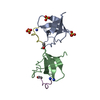
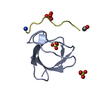
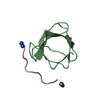
 Components
Components Homo sapiens (human) / Gene: NCK1, NCK / Plasmid: PET28a(+) / Production host:
Homo sapiens (human) / Gene: NCK1, NCK / Plasmid: PET28a(+) / Production host: 
 X-RAY DIFFRACTION / Number of used crystals: 1
X-RAY DIFFRACTION / Number of used crystals: 1  Sample preparation
Sample preparation SYNCHROTRON / Site:
SYNCHROTRON / Site:  SLS
SLS  / Beamline: X10SA / Wavelength: 1.00005 Å
/ Beamline: X10SA / Wavelength: 1.00005 Å Processing
Processing MOLECULAR REPLACEMENT
MOLECULAR REPLACEMENT Movie
Movie Controller
Controller


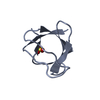

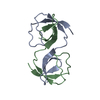
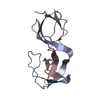





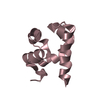


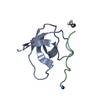
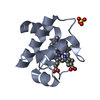
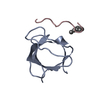
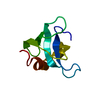

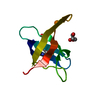
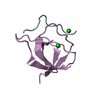
 PDBj
PDBj